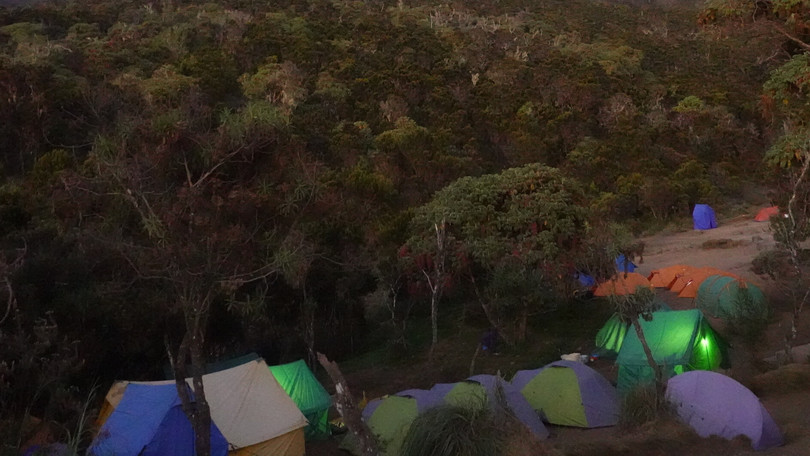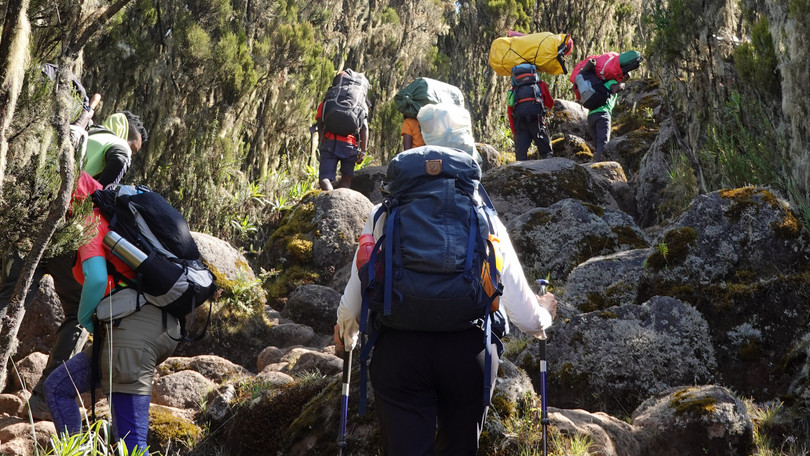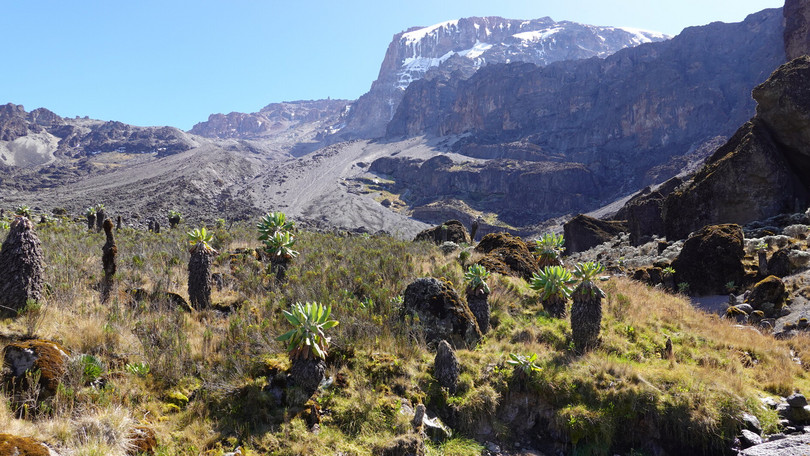The value of nature
Climbing Kilimanjaro for healing cancer
2023-01-23 While dealing with cancer treatment, Prof. Dr. Berta Martín-López climbed Kilimanjaro, the highest free-standing mountain in the world. She transformed her challenge into a contribution to sustainable development in the region through a fundraising campaign for Tanzanian cancer patients. Her personal engagement follows the scientific engagement in a research project about the impact of nature on people’s wellbeing. This is more than only a story. That’s why she invited Carsten Bruhn from Leuphana’s Hochschulsport, who trained her in the previous year, and her PhD Student Milena Gross, with whom she shared not only a tent for a week but also an experience of a lifetime at the roof of Africa.
- Dear Berta, what is your focus as a sustainability scientist at Leuphana?
I research the role of values, knowledge, and institutions in supporting transition pathways towards sustainability. To create a holistic picture of reality, I participate in interdisciplinary projects which scientists from different disciplinary and cultural backgrounds. To do so, I apply an ethos of care throughout the research process, deeply respecting and integrating those who are part of the research process.
- Please tell us more about your current research project.
Berta: We are studying how nature contributes to people’s quality of life around Kilimanjaro and why nature is important to people. Since 2021, scientists from all continents of the world working in Tanzanian, Swiss and German universities are doing socio-ecological research. A predecessor project monitored the mountain’s biodiversity but did not consider its people comprehensively. If we want to preserve nature, we have to understand people’s relationship with it. The region is under severe land-use, climate, and governance change. The mountain’s growing population increasingly demands nature’s contributions to people and pressures ecosystem functioning. Our results will provide the scientific basis for political and societal decision-making towards a sustainable transformation.
- Milena, your PhD thesis with Leuphana University Lüneburg is integrated into the project at Kilimanjaro. What makes the region unique?
Milena: The mountain is a hotspot of biological and cultural diversity being designated a national park in 1973 and World Heritage Side in 1987. Because of its altitudinal gradient, it harbors diverse ecosystems such as savanna, rainforest, and alpine shrubland. Basically, you walk from the equator towards the pole, about 300 kilometres south of the equator is the Kilimanjaro massif in north-eastern Tanzania.You basically walk (up) from the equator to the pole, just 300 kilometer south of the equator. On the foothills, the Chagga tribe runs home gardens based on agroforestry principles. The natural richness fulfills not only their basic needs but allows them to earn money, invest into education, and pay hospital bills. Kilimanjaro’s benefits go beyond the region: The mountain provides water to millions of people with rivers flowing to the capital city Dar Es Salaam and revenue from touristic activities is being shared with families in the whole country.
- How do you engage the local community?
Berta: If solutions are developed with stakeholders, they are more likely to be implemented. That’s why our project considers inhabitants, tourism managers, visitors, and many others. We respect the local knowledge by asking about their stories before creating surveys that imply all answers. We try to use inclusive research methods. They are not only based on words but also on art that shows how people value nature. For example, we apply the method of photo-voice. The scientists ask respondents different guiding questions like: Which place brings you beautiful memories? Where do you feel the most connected? In addition to their answer, the participants shoot and share photos of that site. Those are geo-located so that we have a GPS map of all the places that are most important to people. By analyzing narratives of the stories and elements of the photos, we are investigating more social and spiritual values of nature.
- To you, sustainability is more than a job and Kilimanjaro more than a research site. Why do you have such a personal relationship with the mountain?
Berta: My excitement of receiving the research project in 2020 was suddenly wiped out with the diagnosis of breast cancer. While going through chemotherapy in Lüneburg, in the darkest time of my life, I started to dream about hiking up Kilimanjaro. This dream became soon my motivation to continue with the cancer treatment and to start training. The hike is very challenging. Many suffer from altitude sickness due to the lack of oxygen and some even die. One year before the journey, I was in a very bad condition due to the side-effects of cancer treatment. Then, I approached Carsten Bruhn, the head coach of the gym at Leuphana.
- Carsten, how did you help prepare Berta for the hike?
Carsten: It wasn’t until our second meeting that she revealed her plan of climbing Kilimanjaro. I study sports at Leuphana and consulted my professor for altitude training. In our small gym, I couldn’t equip Berta with oxygen masks or anything. So, we began a beginners’ workout for the full body with isolated movements and fascia training. Over the months, we saw great progress but also major setbacks due to the treatment. Therefore, we had to figure out different methods for different conditions. I never saw someone train so hard and was surprised that she kept smiling.
- During these challenging times, you decided to bring your inner sustainability into the region with a fundraising campaign. How will it benefit the community of Kilimanjaro?
Berta: We want to support people in the region who might not be as lucky as me and do not have access to cancer treatment. In February 2023, we plan to donate the funds to the Cancer Care at the Kilimanjaro Christian Medical Center. Until then, the fundraising campaign is still open for donations.
- Berta and Milena, you made it to the summit of Kilimanjaro on 16 September 2022. Congratulations! Please, tell us more about the adventure.
Berta: The whole journey was very helpful for my mental health. Day after day, I felt stronger and more connected not only with nature, but with heaven – literally, we were above the clouds most days –, with the team and with myself. It is a journey where support and community are at the core, where we learned to listen to our bodies. In the beginning, our mountain guide, Kevin, reminded us to slow down – “polepole” as they say in Swahili. But later, he started pushing us faster and faster. Sometimes, all of us need that trustful relationship with someone who believes more in our capacities than we do.
Milena: The hike makes you humble as it causes each individual climber to become a human being in a very elementary way, no matter which role(s) they take on in daily life. The week was mainly for basic needs: walk, eat, sleep, but also restorative and inspirational. For me, it was a reminder and a surprise of what I am capable of. Researching at Kilimanjaro is much more challenging than climbing it. Endurance is a key factor to succeed in both.
- You were not the first person to aim at hiking up Kilimanjaro after cancer. In fact, scientific research shows that the journey has helped other breast cancer survivors to enhance their well‐being by embracing life, gaining personal strength, personal control and a sense of closure. Why?
Berta: Somehow, there are parallels between the challenges posed by cancer treatment and the hike. With both, you have to take one step at a time. When you go through cancer treatment, you don't recognize your body anymore. Hiking up Kilimanjaro helped me to reconcile myself with my body; I regained the trust in it. It helped me to realize the miracle of our bodies and their capacity to recover. But I think that the main reason is to have a ritual to transit from the sick- to the healthy-world. Our societies have rituals for big life events: love-marriage, entering adulthood, birth and death; but we don't have rituals to celebrate something as important: being alive after cancer. For many of us, this means a re-birth. Yet there is no ritual that helps us make this transition. For me, hiking up Kilimanjaro became that ritual, the celebration of resisting and re-existing.
- You are going back to Tanzania in February. What are your plans?
Milena: We want to give back to those who contributed to our research or who are interested in the results. We would not have succeeded without the help of people who were intrinsically motivated to support our project in their own ways. That’s what we would like to highly acknowledge. For next spring, we plan an outreach tour in different places such as the Kilimanjaro National Park Authority, in targeted villages but also at the international school in Moshi. We have chosen an exhibition format that is accessible and understandable, including photos, paintings and posters. We hope to allow participants to network and to engage in collective conversations.
Berta: Scientists usually gather data and then leave the research area. From our perspective, this is ethically not right. That’s why our plan is to present our results to diverse groups of actors. And we want to define the next research questions together with the stakeholders of Kilimanjaro. Also, I want to honor and thank all the companions who supported my journey, including not only the research team and Carsten Bruhn but also the excellent oncologist team led by Prof. Dall at the Brustkrebszentrums Lüneburg and the wonderful team who guided us up to the top of Mount Kilimanjaro led by Sophie Agustino, CEO of Matriarch Hill Safari.
- Thank you for your personal and scientific engagement!



